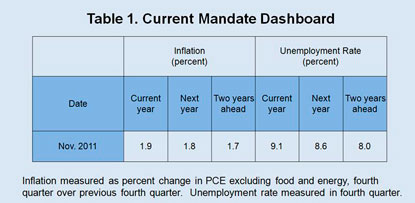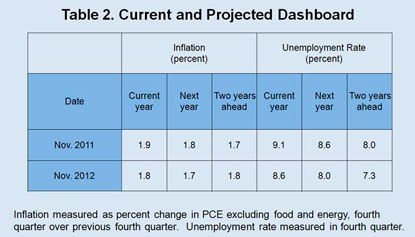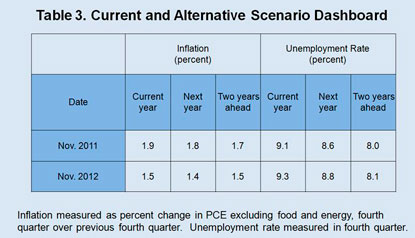- Summary(video)
What I would like to do today is provide a summary of a speech that I gave on November 29 at Stanford University. The theme of the speech is that the Federal Open Market Committee (FOMC) should do more than simply decide at each meeting whether or not to buy more assets or to keep interest rates low for longer. The Committee should provide a public contingency plan—that is, provide guidance to the public on how it will respond to a variety of relevant scenarios. But how should the FOMC formulate a public contingency plan? The FOMC has two statutory mandates: to promote price stability and to promote maximum employment. Given these mandates, it makes sense for the FOMC to vary its chosen level of monetary accommodation in response to changes in current and expected inflation and current and expected unemployment.
I find it helpful to summarize the relevant information in what I term a mandate dashboard. Here’s what the dashboard looked like in the FOMC meeting earlier this month.
I’ll explain the dashboard starting with the inflation side. The first cell from the left is current inflation. The second cell is what inflation is projected to be in one year’s time. Finally, the third cell contains a forecast for inflation in two years’ time. The unemployment side is similar. The first cell from the left is current unemployment. The second cell contains a forecast for unemployment in one year’s time, and the third cell is a forecast for unemployment in two years’ time. The various forecasts are based on the Summary of Economic Projections released by the FOMC earlier this month.
It is important to note that the dashboard includes information from other current variables besides inflation and unemployment. The forecasts for inflation and unemployment could potentially be based on a wide range of information—anticipated changes in fiscal policy, changes in European financial markets and so on. So, basing policy on the mandate dashboard does allow policy to react to changes in these other economic variables. However, using this kind of dashboard does require monetary policy to respond to any economic variable only insofar as that variable affects current and future inflation or unemployment. This restriction seems appropriate given the limited nature of the FOMC’s statutory assignment from Congress.
Given this mandate dashboard, how should the level of monetary accommodation evolve over time in response to changes in the dashboard’s readings? In general, the answer to this question is subtle, because it depends on how the FOMC weights its two mandates. However, there are two common cases in which the mandate dashboard becomes straightforward to use. Suppose current and expected inflation rise and current and expected unemployment fall, as is often true in a recovery. Then, regardless of how it weights its two mandates, the FOMC should reduce the level of accommodation. Alternatively, suppose inflation and expected inflation go down and unemployment and expected unemployment go up, as is often true when the economy slows. Then, regardless of how it weights its two mandates, the FOMC should increase the level of accommodation.
A public contingency plan for 2012 would specify how the FOMC would act in a number of scenarios for the mandate dashboard in a year’s time. It’s useful to start with the FOMC’s projected scenario for 2012.
Notice that the second cell for the November 2012 row is the forecast for inflation over the course of 2013, and the second cell for the November 2011 row is the forecast for inflation over the course of 2012. We generally think that monetary policy operates with a one- or two-year lag. Accordingly, the dashboard keeps track of what we expect the economy to be like in a year or two.
If we compare the second row with the first, we see that in this scenario, core inflation is about the same in a year’s time as it is now. Unemployment is lower. These changes imply that the Committee should reduce the level of monetary accommodation over the coming year. But, like those of many private sector forecasters, the FOMC’s projections have proven imperfect over the past few years. With that in mind, the Committee should provide guidance to the public about how it will respond to unexpected changes in the mandate dashboard. Suppose, for example, that the following alternative scenario occurs in 2012, in which economic conditions are worse than expected:
In this alternative scenario, inflation has fallen since November 2011 and unemployment has risen since November 2011. Here the Committee should increase the level of accommodation relative to November 2011.
In this way, a public contingency plan would allow people to better predict how the Committee plans to react to a variety of economic scenarios. In a speech given in May 2010, Chairman Bernanke stated, “Transparency regarding monetary policy … not only helps make central banks more accountable, it also increases the effectiveness of policy.”1 I agree completely with this sentiment. And I see a public contingency plan, based on the explicit use of metrics like the mandate dashboard, as promoting exactly the kind of transparency that Chairman Bernanke was describing. Thank you.
Making Monetary Policy: Public Contingency Planning Using a Mandate Dashboard - Full Speech
Endnotes
1 See Chairman Bernanke’s May 25, 2010, speech, “Central Bank Independence, Transparency, and Accountability.”





